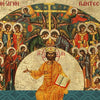The Monastery of Daphni in Chaidari. A historic treasure located at a historic street

One of the most important examples of Byzantine architecture in the period of prosperity, the Daphni Μonastery in Chaidari, is included among the greatest monuments of Greece. Its location, on the Iera Odos axis, the ancient road which was leading from Athens to Elefsina and was taken by all those who participated in the Eleusinian Mysteries, is yet another sample of this historic route. As it was discovered, it is built on the ruins of an ancient sanctuary of Apollo that had destroyed in A.D. 296 and in its place was built the monastery which for centuries was inhabited or abandoned depending on the conditions prevailing at the time. The new monastery which we can see today was built in 1100 during the reign of Alexios I Komnenos.
The church, which is a variation of the cross-in-square octagonal type, is characterized by a large dome, the rich brick patterns that adorn the exterior walls, the outstanding marble inner lining and the masterpiece mosaics. During the Frankish period, the crusaders gave the monastery to the Cistercian monks, while in 1458 it was handed over to Mehmed II known as Mehmed the Conqueror, who returned the ownership of the monastery to the Orthodox monks. It was used as a garrison during the Greek revolution against the Turkish domination, while from 1883 and for two years it was used as a public mental hospital. Towards the end of the 19th century, it was threatened by collapse and ever since up until today restoration work is continuously carried out.
http://odysseus.culture.gr/h/2/gh251.jsp?obj_id=1514
The church, which is a variation of the cross-in-square octagonal type, is characterized by a large dome, the rich brick patterns that adorn the exterior walls, the outstanding marble inner lining and the masterpiece mosaics. During the Frankish period, the crusaders gave the monastery to the Cistercian monks, while in 1458 it was handed over to Mehmed II known as Mehmed the Conqueror, who returned the ownership of the monastery to the Orthodox monks. It was used as a garrison during the Greek revolution against the Turkish domination, while from 1883 and for two years it was used as a public mental hospital. Towards the end of the 19th century, it was threatened by collapse and ever since up until today restoration work is continuously carried out.
http://odysseus.culture.gr/h/2/gh251.jsp?obj_id=1514
-
Posted in
Current Affairs





